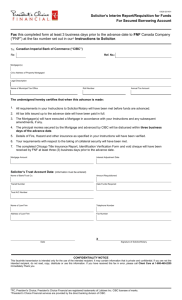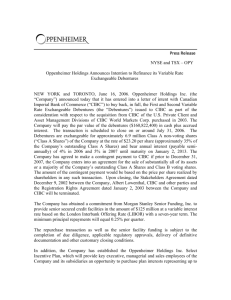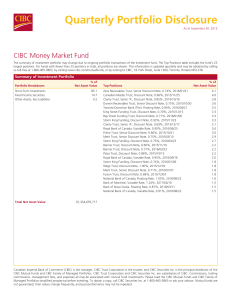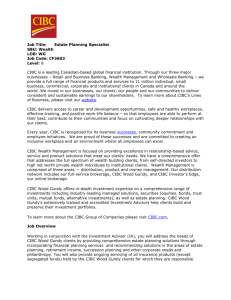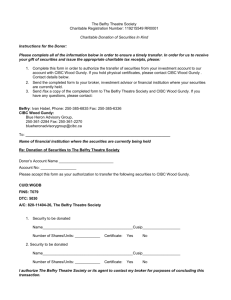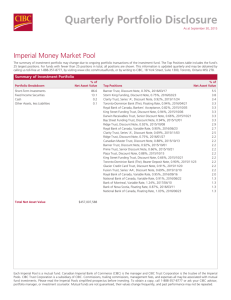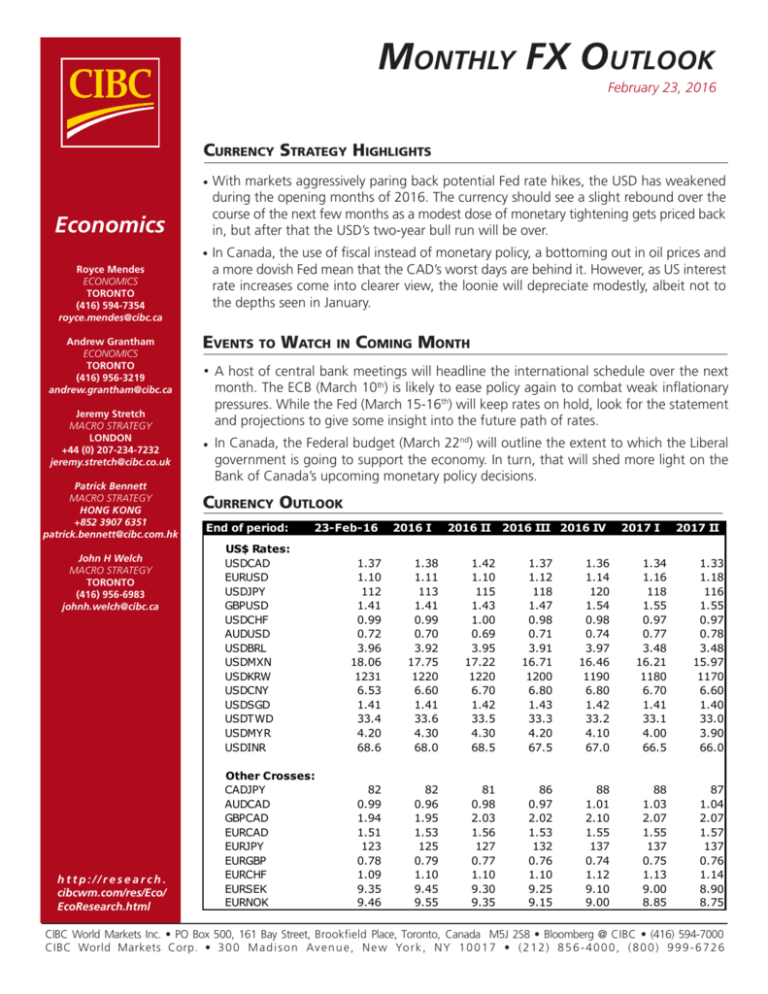
Monthly FX Outlook
February 23, 2016
Currency Strategy Highlights
• With markets aggressively paring back potential Fed rate hikes, the USD has weakened
Economics
during the opening months of 2016. The currency should see a slight rebound over the
course of the next few months as a modest dose of monetary tightening gets priced back
in, but after that the USD’s two-year bull run will be over.
• In Canada, the use of fiscal instead of monetary policy, a bottoming out in oil prices and
Royce Mendes
ECONOMICS
TORONTO
(416) 594-7354
royce.mendes@cibc.ca
Andrew Grantham
ECONOMICS
TORONTO
(416) 956-3219
andrew.grantham@cibc.ca
Jeremy Stretch
MACRO STRATEGY
LONDON
+44 (0) 207-234-7232
jeremy.stretch@cibc.co.uk
Patrick Bennett
MACRO STRATEGY
HONG KONG
+852 3907 6351
patrick.bennett@cibc.com.hk
John H Welch
MACRO STRATEGY
TORONTO
(416) 956-6983
johnh.welch@cibc.ca
http://research.
cibcwm.com/res/Eco/
EcoResearch.html
a more dovish Fed mean that the CAD’s worst days are behind it. However, as US interest
rate increases come into clearer view, the loonie will depreciate modestly, albeit not to
the depths seen in January.
Events
to
Watch
in
Coming Month
• A host of central bank meetings will headline the international schedule over the next
month. The ECB (March 10th) is likely to ease policy again to combat weak inflationary
pressures. While the Fed (March 15-16th) will keep rates on hold, look for the statement
and projections to give some insight into the future path of rates.
• In Canada, the Federal budget (March 22nd) will outline the extent to which the Liberal
government is going to support the economy. In turn, that will shed more light on the
Bank of Canada’s upcoming monetary policy decisions.
Currency Outlook
End of period:
23-Feb-16
US$ Rates:
USDCAD
EURUSD
USDJPY
GBPUSD
USDCHF
AUDUSD
USDBRL
USDMXN
USDKRW
USDCNY
USDSGD
USDTWD
USDMYR
USDINR
Other Crosses:
CADJPY
AUDCAD
GBPCAD
EURCAD
EURJPY
EURGBP
EURCHF
EURSEK
EURNOK
2016 I
2016 II 2016 III 2016 IV
2017 I
2017 II
1.37
1.10
112
1.41
0.99
0.72
3.96
18.06
1231
6.53
1.41
33.4
4.20
68.6
1.38
1.11
113
1.41
0.99
0.70
3.92
17.75
1220
6.60
1.41
33.6
4.30
68.0
1.42
1.10
115
1.43
1.00
0.69
3.95
17.22
1220
6.70
1.42
33.5
4.30
68.5
1.37
1.12
118
1.47
0.98
0.71
3.91
16.71
1200
6.80
1.43
33.3
4.20
67.5
1.36
1.14
120
1.54
0.98
0.74
3.97
16.46
1190
6.80
1.42
33.2
4.10
67.0
1.34
1.16
118
1.55
0.97
0.77
3.48
16.21
1180
6.70
1.41
33.1
4.00
66.5
1.33
1.18
116
1.55
0.97
0.78
3.48
15.97
1170
6.60
1.40
33.0
3.90
66.0
82
0.99
1.94
1.51
123
0.78
1.09
9.35
9.46
82
0.96
1.95
1.53
125
0.79
1.10
9.45
9.55
81
0.98
2.03
1.56
127
0.77
1.10
9.30
9.35
86
0.97
2.02
1.53
132
0.76
1.10
9.25
9.15
88
1.01
2.10
1.55
137
0.74
1.12
9.10
9.00
88
1.03
2.07
1.55
137
0.75
1.13
9.00
8.85
87
1.04
2.07
1.57
137
0.76
1.14
8.90
8.75
CIBC World Markets Inc. • PO Box 500, 161 Bay Street, Brookfield Place, Toronto, Canada M5J 2S8 • Bloomberg @ CIBC • (416) 594-7000
CIBC World Markets Corp. • 3 0 0 M a d i s o n A v e n u e , N e w Yo r k , N Y 1 0 0 1 7 • ( 2 1 2 ) 8 5 6 - 4 0 0 0 , ( 8 0 0 ) 9 9 9 - 6 7 2 6
CIBC World Markets Inc.
Monthly FX Outlook - February 23, 2016
USD Springs a Leak
Add it all up, and after a short rally, the two-year bullrun in the USD will have come to an end. It’s not all bad
news though. The slightly softer exchange rate should
be less of a drag on the economy as it tries to navigate
the choppy.
Risks to the Fed’s tightening cycle have always been
tilted to the downside. That’s why our fed funds
forecasts have exhibited a gentler path than those in
the FOMC’s Summary of Economic Projections.
Loonie Has Seen Its Worst
Even eight years after the financial crisis, the persistence
of weak inflationary pressures would have made it
difficult to implement the type of tightening suggested
by the FOMC forecasts. That said, recent financial
market jitters have added another headwind and, as a
result, a March rate hike has now been taken off the
table.
With Canadian monetary policy taking a backseat to
fiscal stimulus, Fed rate hikes being delayed until later
in the year and oil prices appearing to have bottomed
out we’ve strengthened our near-term forecast for the
Canadian dollar. Indeed, it’s now likely that the loonie
has seen the worst of the depreciation, even if it has
one slight dip ahead.
Indeed, sentiment has turned so sour that the futures
market is barely even pricing in 25bps of tightening
over the next two years (Chart 1, left). But recent talk
of a recession is overdone, and CIBC Economics is still
projecting two rate hikes in 2016. As markets move to
price in that modest dose of tightening, the USD should
regain some ground during the first half of the year.
The Bank of Canada’s decision to keep rates on hold
in January represented an important turning point for
the currency. Since reaching its weakest level on the
day before the announcement, a time when markets
were pricing in a high probability of further monetary
easing, the CAD has appreciated more than five
percent. In part, that strength reflects the perception
that Governor Poloz has given way to his boss, Finance
Minister Morneau.
However, even rate hikes won’t be able to stop the
currency from leaking lower during the latter part
of 2016. By that time, other economies will have
begun reaping the rewards of past stimulus, making
the outlooks for monetary policies less disparate. The
US’s trade deficit will also weigh on the greenback
as it becomes increasingly viewed in contrast to the
surpluses seen in regions like the euro area (Chart 1,
right).
The use of deficit spending by the Liberal government
to stimulate the economy means that the pressure on
the currency from potential monetary easing has been
significantly reduced. Indeed, according to a technical
report by the Bank of Canada, $10 bn worth of fiscal
stimulus has more of an effect on GDP than a reduction
of 100bps in the overnight rate (Chart 2 left).
Chart 2 - Planned Fiscal Stimulus Will Be More Potent Than
An Additional Rate Cut (L); Oil Market to Reduce Excess
Supply as Demand Accelerates (R)
2.5
2
0.4
1
0.3
0
0.2
1.5
0.25
-1
0.1
1.0
0.00
-2
0.0
0.75
Aug-17
Current
As of Dec.
Source: Bloomberg,
CIBC31, 2015
Nov-17
Feb-17
May-17
Nov-16
Aug-16
May-16
Feb-16
0.50
0.5
25bp Rate Cut $10B Fiscal
Stimulus
0.0
25bp Rate Cut
-0.5
$10B Fiscal Stimulus
Source: Bloomberg, CIBC
-3
-4
US
2.0
Eurozone
Source: Bloomberg, Haver Analytics, CIBC
16Q4
1.00
IEA Projected Oil Market
Balance (Millions of
Barrels Per Day)
16Q3
0.5
3.0
16Q2
1.25
Change in Annual
16Q1
3
0.6
15Q4
1.50
Current Account
Balance as a % of GDP
15Q3
4
Fed Funds Futures
15Q2
1.75
15Q1
Chart 1 - Futures Market Only Pricing in One Fed Rate Hike
Over the Next Two Years (L); US Current Account Will Weigh
on the Currency (R)
Source: Bank of Canada, IEA, CIBC
2
CIBC World Markets Inc.
Monthly FX Outlook - February 23, 2016
Pressure on the loonie from further Fed rate hikes has
also been delayed. Market volatility and a string of
soft data has seen the FOMC take a step back from
their hiking cycle. While the US central bank could still
raise rates later in the year, it would likely happen in
an environment of better global growth and higher
oil prices. CIBC Economics expects oil prices to recover
during the year with supply leveling off and demand
continuing to increase (Chart 2, right). That would
provide at least a partial cover for the loonie from wider
interest rate differentials. We say partial cover because
the currency will still depreciate as monetary policy
diverges, but it won’t reach the depths seen in January.
Chart 3 - Eurozone Inflation Expectations Have Moved
Lower Recently (L); With the Fed Delaying Rate Hikes,
Pressure on the Euro from Widening Spreads Should
Dissipate (R)
2.00
5Y5Y Inflation Expectations 1.25
1.00
1.20
1.25
1.15
1.75
1.50
1.10
1.75
1.05
1.50
1.00
Jan-15
EURUSD
As a result, the CAD shouldn’t deviate too far from its
current level over the remainder of the year. Looking
ahead, as oil prices grind higher, the loonie should
appreciate slightly, albeit remaining weak enough to
keep the non-energy export sector competitive on the
global stage.
1.25
Jan-15
Jul-15
Jan-16
2.00
Jan-16
5YR US-Germany Spread
(RHS,
Inverse)
Source:
Bloomberg, CIBC
Source: Bloomberg, CIBC
than what markets currently expect, the currency is
unlikely to depreciate much from current levels. That’s
because the one-way policy divergence trade with the
US is now much more uncertain (Chart 3).
EUR: What’s Left in Mario’s Cart?
ECB President Mario Draghi has already unleashed a
sizeable wave of central bank stimulus, but it hasn’t
been enough to combat the deteriorating outlook for
inflation. Over the past two months, 5y5y inflation
expectations have fallen 40bps, reaching their lowest
level on record. While it’s often argued that these
market-based inflation expectations are not perfect
measures of the actual level of expectations, the move
lower is nonetheless troubling for the ECB.
Just as ECB policy appears to be reaching its limits,
FOMC voters are stepping away from a March rate
hike. As a result, look for the euro to decline slightly
following the next round of easing, but to remain
above the 1.10 mark over the next couple of quarters.
JPY: Who Surprised Who?
It will likely influence some of the hawkish board
members to vote in favour of more substantive easing
during the central bank’s upcoming meeting on March
10. As a result, look for the ECB to cut the deposit
rate another 20bps, taking it down to -0.50%. In an
attempt to protect banks, following the example of
the BoJ, lower rates would likely be accompanied by a
move to a tiered system where existing deposits don’t
incur additional costs. The banking sector has already
been hit by new bail in rules that took effect on January
1, the ECB doesn’t want to add to the negativity
surrounding the sector.
The BoJ surprised just about everybody when it took
rates into negative territory a few weeks ago. But the
market may have gotten the last laugh, as it stunned
the central bank by bidding up the value of the yen in
the aftermath.
While President Draghi will play up the central bank’s
ability to ease policy further, questions will be raised
about how much firepower he really has left. Markets
have yet to fully price in additional easing, as they don’t
want to get caught offside for a second meeting in a
row. However, even if the central bank delivers more
However, that misconception can’t explain why
the currency has continued to appreciate or why
speculators are maintaining their elevated level of
long yen positions (Chart 4). Despite a broad softening
in the US dollar, USDJPY is now trading around its
average during the last quarter of 2014.
After taking a few days to digest the details of
the policy move, markets decided that it was less
aggressive than initially believed. As the BoJ will now
have different tiers of reserves, it seems that only
about 12% will be impacted by the newly announced
negative rates.
3
CIBC World Markets Inc.
Monthly FX Outlook - February 23, 2016
While we admit that the likelihood of a BoE hike this
year is fading, pricing an ease at this point appears
extreme. The BoE’s projections show that the output
gap is narrower, despite downgraded GDP forecasts.
And the unemployment rate has moved down again.
Wage inflation has eased again after seeming to be on
an uptrend earlier, but that could be because of the
link between pay increases and headline CPI. With
oil prices stabilizing, albeit at lower levels, signs of CPI
and wage inflation starting to pick up should be more
evident in the second half of the year.
Chart 4 - Despite the Recent Appreciation in the Currency,
Speculative Positions in the Yen Remain Long
Net Speculative Yen Positions
40000
20000
0
-20000
-40000
-60000
-80000
-100000
-120000
So while sterling could remain on the defensive in the
near-term thanks to speculation on EU membership
(Chart 5, right), an expected decision to remain part
of the European community and a modest pick-up in
inflation should see it recover to 1.54 versus the USD
by year-end.
Feb-16
Source: Bloomberg, CIBC
Nevertheless, given that the reduction in rates wasn’t as
aggressive as initially thought, it does leave some tools
in Kuroda’s toolbox for future use. That leaves risks
skewed toward further action out of the central bank,
since the longer the currency remains at these levels,
the less likely it will be that the CPI target is achieved.
AUD: Lost in Transition
Much like here in Canada, the central bank of Australia
is trying to guide the economy through a period of
transition between resource-fuelled growth and an
economy supported by other drivers. Judging by the
Q4 employment figures, it appeared at first as if the
economy was managing this period of transition very
well. However, the Secretary of the Treasury later
described the strong employment gains over this period
as being the result of “technical issues”.
Sterling a Risky Bet in Near Term
In a risk off world, Sterling remains an underperformer.
Uncertainty regarding the UK’s place in Europe and
the country’s reliance on capital inflows thanks to a
large current account deficit have kept sterling on
the defensive since the start of the year. And that
underperformance could continue through the first half
of the year as well.
The RBA appears to be of two minds regarding policy.
It welcomes a cheaper currency as providing a boost
A June 23rd date for the UK’s referendum on EU
membership has been confirmed, leaving plenty of
time still for opinion polls to provide impetus for the
currency. However, much like during run up to the
general election and Scottish referendum, we suspect
that the deteriorating opinion polls overstate the risk
of “Brexit” (Chart 5, left).
Chart 5 - EU Membership Opinion Polls Have Deteriorated
Recently (L), Just as the Topic is Gaining More Attention (R)
UK Opinion Polls on Staying vs
Internet Search Popularity
Leaving EU (%-pt difference, 120
(Index 100 = max)
20%
rolling avg)
100
16%
Majority in Favour
80
12%
Grexit
of Staying
Brexit
60
8%
4%
Jan-16
Nov-15
Jul-15
Sep-15
May-15
0
Jan-15
Jan 2016
Dec 2015
Jun 2015
-4%
20
Majority in Favour
of Leaving
Nov 2015
0%
40
Mar-15
Fear that the UK could leave the EU isn’t the only
source of sterling weakness, however. Downgrades to
growth expectations and the uncertain international
outlook has seen financial markets move from pricing
in the probability of a BoE rate hike not long ago, to
pricing a 40% likelihood that Carney and co. will follow
the lead of the ECB and cut rates below their Great
Recession lows.
Oct 2015
Jan-16
Dec-15
Nov-15
Oct-15
Sep-15
Aug-15
Jul-15
Jun-15
Apr-15
Source: Bloomberg, CIBC
May-15
Mar-15
Jan-15
Feb-15
-140000
Sep 2015
60000
Source: Bloomberg, CIBC
Source: Bloomberg, CIBC
4
CIBC World Markets Inc.
Monthly FX Outlook - February 23, 2016
SEK to gradually gain ground against the euro, as the
ECB continues to ease policy.
to parts of the economy exposed to international
pressures. Yet it says that the currency is merely a
reflection of lower commodity prices, and is reticent
to ease interest rates again due to rising private sector
credit and home loans. In his semi-annual Parliamentary
testimony, Governor Stevens indicated that the bank
maintains a bias toward easing due to a benign
inflation backdrop, but that there is no rush to cut
rates further.
NOK Moving With Oil Prices
With weak oil prices impacting the economy, look for
the Norges bank to cut rates by 25bps to 0.50% on
March 17. However, unlike most other economies in
the area, there are no deflation concerns at this point.
As a result, the central bank should be able to avoid
negative territory on rates for now.
With uncertainty remaining regarding the global
economic backdrop, it is hard to call a trough in
commodity prices or by extension the Aussie dollar yet.
However, a brighter outlook for commodity demand by
year-end should see a recovery to 0.74 versus the USD.
While weaker oil prices highlight the fact that growth
will remain weak, we expect oil prices to gradually
increase over the course of the year. That should
support both the economy and the EURNOK exchange
rates. Look for the currency to follow oil prices
moderately higher during the year and into 2017.
Swiss Policymakers to Follow ECB
Given that we expect the ECB to cut rates again in
a few weeks, it seems likely that the Swiss National
Bank would have to follow suit. To keep the EURCHF
exchange rate stable, Chairman Jordan will have to
make good on his statement that the deposit rate has
yet to reach rock bottom.
Brazilian Inflation Still Charging Ahead
Brazilian markets came back from the Carnaval festival
buffeted by international markets and the return of
activities in congress. USDBRL quickly caught up with
global market sentiment, spiking to above 4.00 and
has oscillated around that level since then. General
pessimistic sentiment remains, especially with the
lack of fiscal adjustment. The government delayed
announcing necessary expenditure cuts once again and,
even then, most expect them to prove insufficient to
guarantee a primary surplus in 2016. Monetary policy is
tight, but inflation continues to accelerate. As a result,
we think we have seen the highs in USDBRL and look
to sell it on any spike (Chart 6).
As a result, we expect the twin policies of foreign
exchange market intervention and negative deposit
rates to persist for some time. Despite removing the
peg to the euro, the central bank has seen reserves
increase by about 15%, highlighting the fact that
policymakers remain very active in the foreign exchange
market.
Look for the SNB to undertake as much easing as is
necessary to keep the exchange rate stable around
current levels for the rest of the year.
Chart 6 - USDBRL Spot, the SELIC Policy Rate, and Inflation
Riksbank Trying to Outdo the ECB
16%
Despite the economy growing at around three percent
for the second year in a row, the Riksbank has been
aggressive with regards to recent policy moves. The
deposit rate was unexpectedly taken further into
negative territory, albeit on the back of a very close
vote. It appears that the central bank is trying to get
ahead of the ECB, which is expected to add additional
stimulus in the near future.
IPCA inflation (% YoY, L)
SELIC rate (L)
USD/BRL (R)
14%
12%
4.0
3.5
2.5
8%
2.0
6%
TARGET
4%
2%
0%
Aug-10
4.5
3.0
10%
At this point, Governor Ingves seems more concerned
with inflation rather than exacerbating inflated asset
prices or leveraged consumers. But we still expect the
Forecast
1.5
1.0
0.5
Dec-11
May-13
Sep-14
0.0
Jan-16
May-17
Source: Bloomberg, CIBC
Source: Banco Central do Brasil, IBGE, CIBC
5
CIBC World Markets Inc.
Monthly FX Outlook - February 23, 2016
THE IBGE reported that January inflation accelerated
to 1.3% or 10.7% year/year, well above consensus of
1.1% and just a bit above our 1.2% forecast. In our
view, that should convince the COPOM to raise the
SELIC rate again in March. The BCB’s needs to tighten
further, but political pressure to stay on hold or even
cut the SELIC remains high.
Chart 7 - Mexico: USDMXN, Fondeo Rate, Headline and Core
Inflation (year/year %)
6.0
5.0
4.0
3.0
Inflation should stay above 9.0% throughout 2016.
Inflation dynamics have not yet turned, but tight
monetary policy could lead to better price dynamics.
However, with the change of Finance Minister, further
substantial fiscal adjustment is less likely.
2.0
1.0
0.0
Aug-10
December 2015 fiscal numbers showed significant
deterioration, but at least markets are now getting
transparent and true numbers. Government fiscal
dynamics, however, remain dangerous. Nevertheless,
look for the currency to gradually gain ground from the
very weak levels seen recently as tight monetary policy
begins to have more of an effect.
19
18
17
16
15
14
13
12
11
10
9
8
7
6
Feb-16 Bloomberg,
Jul-17 CIBC
Source:
Forecast
CPI inflation (y/y %, Left)
Core inflation (y/y %, Left)
Fondeo rate (Left)
USD/MXN (Right)
Jan-12
May-13
Oct-14
Source: Banxico, Bloomberg, CIBC
that the high USDMXN have had on prices could delink
Mexico’s monetary policy from the Fed and prompt it
to raise the overnight rate sooner.
Mexican Central Bank Surprisingly Tightens Policy
Moreover, we noted that 1M USDMXN vols had jumped
above 16 for the first time since September 2013 and
that the last time 1M vols approached 16 (August 2015
and September 2015) Banxico announced new USD
auction measures or modified existing ones. We see
this joint action by Banxico, the FX commission, and the
Ministry of Finance as a proactive measure to correct
the overshot USDMXN. Moreover, we do not see a
significant impact on our growth estimates and expect
2016 GDP growth to come in at 3.00%.
The recent rout in oil prices took USDMXN above
19.00, which in turn caused Banxico to take action
less than two weeks since the last policy meeting.
The central bank increased the fondeo rate by 50 bps
to 3.7%, causing USDMXN to close at 18.00 before
retracing some of the move (Chart 7).
The central bank stated that the hike does not imply the
start of a tightening cycle. However, they will continue
to monitor the exchange rate and its impact on prices
and the relative monetary stance between Mexico and
the US. We expect two more 25bp increases in the
fondeo rate, meaning that it will end 2016 at 4.25%.
CNY, CNH – Depreciation Moderating
There remains a high degree of scrutiny surrounding
Chinese financial markets and the future path of
the yuan, although the overwhelming bearishness
witnessed around the turn of the year has eased
considerably. The softening in the negative tone has,
in part, been associated with a greater acceptance that
the capital outflows seen over the last few months
were a combination of foreign debt repayments,
which is welcome, and companies invested in China
hedging exposures, which will keep some pressure on
the currency though needn’t be destabilizing in the
medium to long-term.
The FX commission suspended its daily USD
auctions, but left open the possibility of discretionary
interventions if the exchange rate deviates from
fundamentals. In a complementary move, Finance
Minister Luis Videgaray, announced MXN 132 bln
expenditure cut equivalent to around 0.7% of GDP. The
federal government will cut MXN 32 bln whereas the
remaining MXN 100 bln will come from PEMEX.
Although the intra-meeting rate announcement took
the market by surprise, this decision responded to the
increase in the upside volatility experienced in USDMXN
since the previous rate announcement. Banxico hinted,
last week, that the fiscal situation and the pressures
To be sure, there has also been some degree of
speculative outflows, but we expect that these have
peaked, at least absent any further deterioration in the
economic outlook.
6
CIBC World Markets Inc.
Monthly FX Outlook - February 23, 2016
The challenge for policymakers has been to educate
the market about their reform intentions. All told, the
process of Chinese market reform and shift toward
international norms is taking time and has hit a few
snags along the way – a great deal of it related to how
other markets have reacted.
For our part, we continue to take a pragmatic view of
the situation. We are forecasting a weakening of the
CNY, but also stick to a view of selling strength rather
than chasing the market at any point. The recent
narrowing between spot USDCNY and USDCNH is a
signal of a nearly neutral market position, thus showing
the opportunity to establish or add to USDCNH longs.
For reference, the spread between USDCNY and
USDCNH is currently around 10-15bps, that’s much
narrower than the 1450bps seen in early January.
Talk of a precipitous decline in the CNY as a result of
capital outflows, a policy to depreciate the currency to
boost exports, or as a result of having to print money
to bail out the banking sector, individually and in
combination, are powerful ingredients for a sensational
narrative. Nevertheless, the PBoC and other officials
have urged that such a result is not justified.
Interest Rate
and
1-year outright USDCNH points that traded near
3500bps are now around 2500bps. That prices around
a 3.8% annualized depreciation of the currency. We
believe the market is currently appropriately priced.
Economic Outlook
End of period:
Canada Overnight target rate
2-Year Gov't Bond
10-Year Gov't Bond
Federal Funds Rate
US
2-Year Gov't Note
10-Year Gov't Note
Eurozone Refin.operations rate
2-Year Gov't Bunds
10-Year Gov't Bunds
Bank rate
UK
2-Year Gilts
10-Year Gilts
Overnight rate
Japan
2-Year Gov't Bond
10-Year Gov't Bond
2016 I 2016 II 2016 III 2016 IV
0.50
0.50
0.50
0.50
0.45
0.50
0.55
0.70
1.20
1.35
1.50
1.60
0.38
0.63
0.63
0.88
0.70
0.95
1.00
1.30
2.00
2.25
2.50
2.60
0.05
0.05
0.05
0.05
-0.45
-0.45
-0.25
-0.20
0.30
0.30
0.40
0.50
0.50
0.50
0.50
0.75
0.50
0.60
0.75
0.90
1.75
1.95
2.15
2.25
0.10
0.10
0.10
0.10
-0.10
-0.15
-0.15
-0.15
0.10
0.10
0.10
0.15
Canada
US
Eurozone
UK
Japan
Real GDP growth (%)
Unemployment rate (%)
CPI (%)
Real GDP growth (%)
Unemployment rate (%)
CPI (%)
Real GDP growth (%)
Unemployment rate (%)
CPI (%)
Real GDP growth (%)
Unemployment rate (%)
CPI (%)
Real GDP growth (%)
Unemployment rate (%)
CPI (%)
2015
1.2
6.9
1.1
2.4
5.3
0.1
1.5
10.9
0.0
2.4
5.5
0.0
0.6
3.4
0.9
2016
1.3
7.2
1.7
2.2
4.4
1.5
1.9
10.1
1.0
2.3
5.0
1.1
1.0
3.1
0.8
2017
2.3
7.0
2.5
2.1
4.2
2.9
1.6
9.5
1.6
2.2
4.8
1.9
0.6
3.2
1.3
This report is issued and approved for distribution by (a) in Canada, CIBC World Markets Inc., a member of the Investment Industry Regulatory Organization of Canada, the Toronto Stock Exchange, the
TSX Venture Exchange and a Member of the Canadian Investor Protection Fund, (b) in the United Kingdom, CIBC World Markets plc, which is regulated by the Financial Services Authority, and (c) in Australia, CIBC Australia Limited, a member of the Australian Stock Exchange and regulated by the ASIC (collectively, “CIBC”) and (d) in the United States either by (i) CIBC World Markets Inc. for distribution
only to U.S. Major Institutional Investors (“MII”) (as such term is defined in SEC Rule 15a-6) or (ii) CIBC World Markets Corp., a member of the Financial Industry Regulatory Authority. U.S. MIIs receiving
this report from CIBC World Markets Inc. (the Canadian broker-dealer) are required to effect transactions (other than negotiating their terms) in securities discussed in the report through CIBC World
Markets Corp. (the U.S. broker-dealer).
This report is provided, for informational purposes only, to institutional investor and retail clients of CIBC World Markets Inc. in Canada, and does not constitute an offer or solicitation to buy or sell any
securities discussed herein in any jurisdiction where such offer or solicitation would be prohibited. This document and any of the products and information contained herein are not intended for the
use of private investors in the United Kingdom. Such investors will not be able to enter into agreements or purchase products mentioned herein from CIBC World Markets plc. The comments and views
expressed in this document are meant for the general interests of wholesale clients of CIBC Australia Limited.
This report does not take into account the investment objectives, financial situation or specific needs of any particular client of CIBC. Before making an investment decision on the basis of any information
contained in this report, the recipient should consider whether such information is appropriate given the recipient’s particular investment needs, objectives and financial circumstances. CIBC suggests that,
prior to acting on any information contained herein, you contact one of our client advisers in your jurisdiction to discuss your particular circumstances. Since the levels and bases of taxation can change,
any reference in this report to the impact of taxation should not be construed as offering tax advice; as with any transaction having potential tax implications, clients should consult with their own tax
advisors. Past performance is not a guarantee of future results.
The information and any statistical data contained herein were obtained from sources that we believe to be reliable, but we do not represent that they are accurate or complete, and they should not be
relied upon as such. All estimates and opinions expressed herein constitute judgments as of the date of this report and are subject to change without notice.
This report may provide addresses of, or contain hyperlinks to, Internet web sites. CIBC has not reviewed the linked Internet web site of any third party and takes no responsibility for the contents thereof.
Each such address or hyperlink is provided solely for the recipient’s convenience and information, and the content of linked third-party web sites is not in any way incorporated into this document. Recipients who choose to access such third-party web sites or follow such hyperlinks do so at their own risk.
© 2016 CIBC World Markets Inc. All rights reserved. Unauthorized use, distribution, duplication or disclosure without the prior written permission of CIBC World Markets Inc. is prohibited by law and may
result in prosecution.
7


